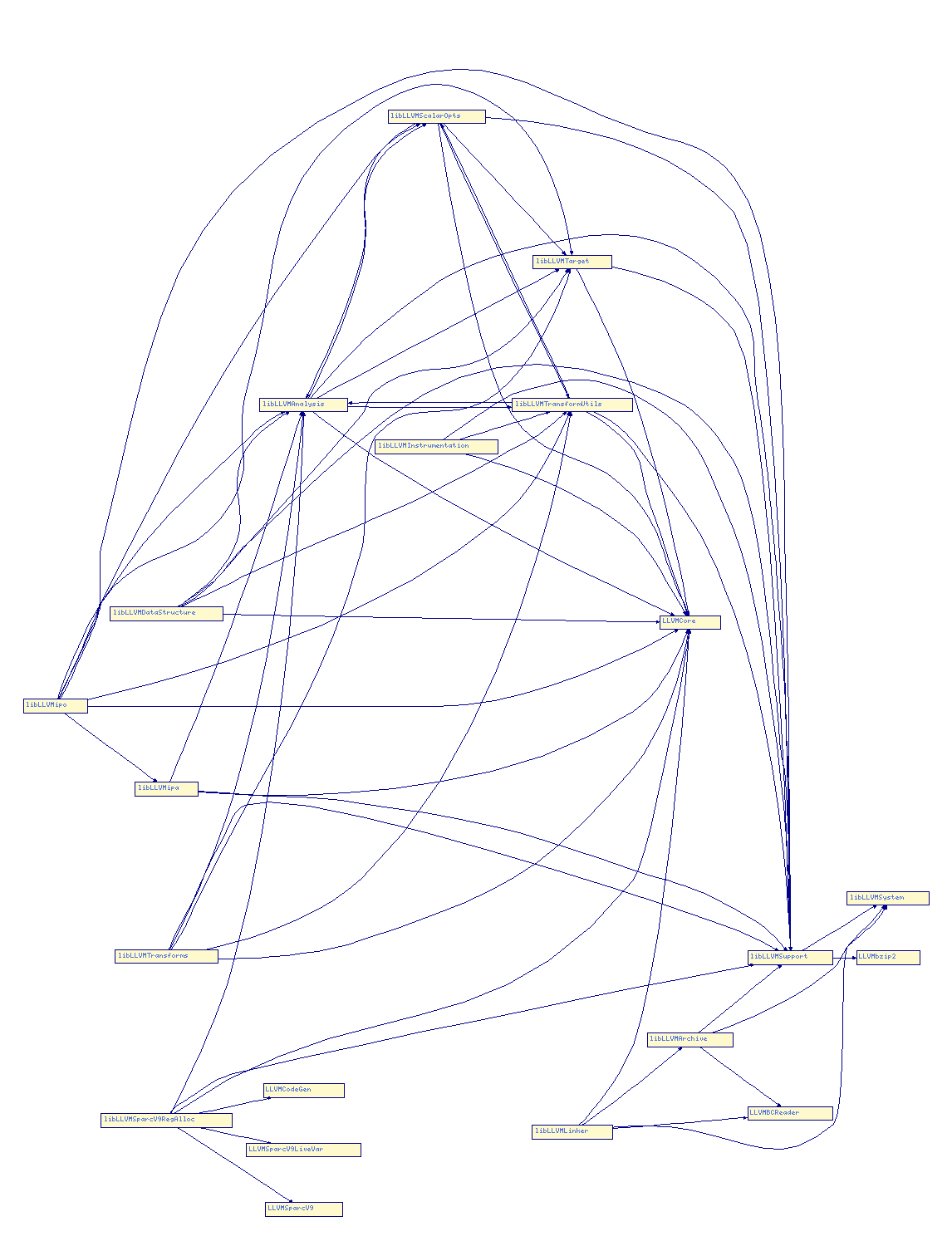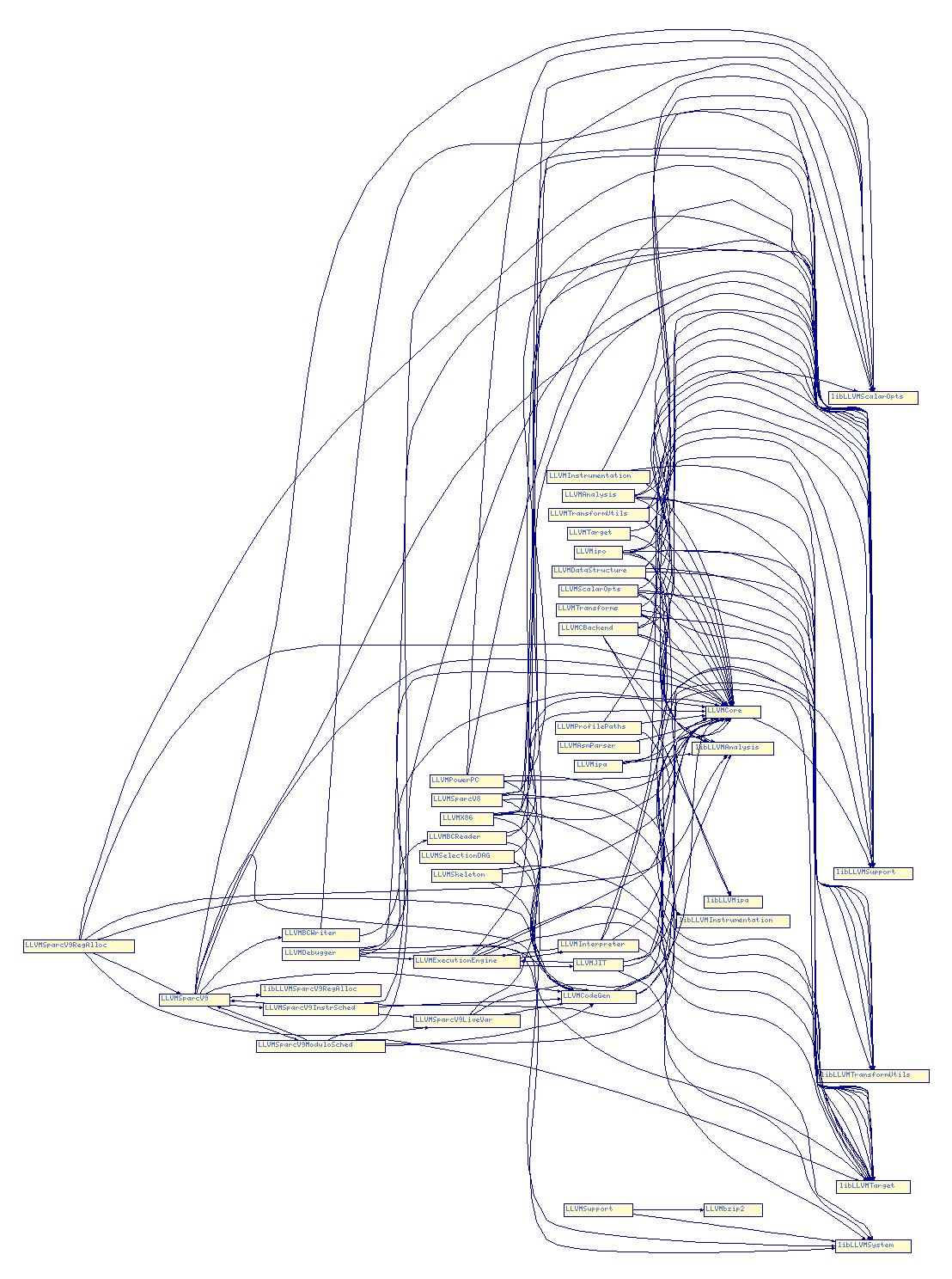Below are two dependency graphs and a list that show the relationships between the various LLVM archive libraries and object files. This information can be automatically generated with the GenLibDeps.pl utility found in the llvm/utils directory.
Dependency Relationships Of Libraries
This graph shows the dependency of archive libraries on other archive libraries or objects. Where a library has both archive and object forms, only the archive form is shown.

Dependency Relationships Of Object Files
This graph shows the dependency of object files on archive libraries or other objects. Where a library has both object and archive forms, only the dependency to the archive form is shown.

The following list shows the dependency relationships between libraries in textual form. The information is the same as shown on the graphs but arranged alphabetically.
- libLLVMAnalysis.a
- libLLVMScalarOpts.a
- libLLVMSupport.a
- libLLVMTarget.a
- libLLVMTransformUtils.a
- LLVMCore.o
- libLLVMArchive.a
- libLLVMSupport.a
- libLLVMSystem.a
- LLVMBCReader.o
- libLLVMDataStructure.a
- libLLVMAnalysis.a
- libLLVMSupport.a
- libLLVMTarget.a
- libLLVMTransformUtils.a
- LLVMCore.o
- libLLVMInstrumentation.a
- libLLVMSupport.a
- libLLVMTransformUtils.a
- LLVMCore.o
- libLLVMLinker.a
- libLLVMArchive.a
- libLLVMSystem.a
- LLVMBCReader.o
- LLVMCore.o
- libLLVMScalarOpts.a
- libLLVMAnalysis.a
- libLLVMSupport.a
- libLLVMTarget.a
- libLLVMTransformUtils.a
- LLVMCore.o
- libLLVMSupport.a
- libLLVMSystem.a
- LLVMbzip2.o
- libLLVMSystem.a
- libLLVMTarget.a
- libLLVMSupport.a
- LLVMCore.o
- libLLVMTransformUtils.a
- libLLVMAnalysis.a
- libLLVMScalarOpts.a
- libLLVMSupport.a
- LLVMCore.o
- libLLVMTransforms.a
- libLLVMAnalysis.a
- libLLVMSupport.a
- libLLVMTarget.a
- libLLVMTransformUtils.a
- LLVMCore.o
- libLLVMipa.a
- libLLVMAnalysis.a
- libLLVMSupport.a
- LLVMCore.o
- libLLVMipo.a
- libLLVMAnalysis.a
- libLLVMipa.a
- libLLVMScalarOpts.a
- libLLVMSupport.a
- libLLVMTarget.a
- libLLVMTransformUtils.a
- LLVMCore.o
- LLVMAnalysis.o
- libLLVMScalarOpts.a
- libLLVMSupport.a
- libLLVMTarget.a
- libLLVMTransformUtils.a
- LLVMCore.o
- LLVMAsmParser.o
- LLVMCore.o
- LLVMBCReader.o
- libLLVMSupport.a
- libLLVMSystem.a
- LLVMCore.o
- LLVMBCWriter.o
- libLLVMSupport.a
- LLVMCore.o
- LLVMCBackend.o
- libLLVMAnalysis.a
- libLLVMipa.a
- libLLVMScalarOpts.a
- libLLVMSupport.a
- libLLVMTarget.a
- LLVMCore.o
- LLVMCodeGen.o
- libLLVMAnalysis.a
- libLLVMSupport.a
- libLLVMTarget.a
- LLVMCore.o
- LLVMCore.o
- libLLVMSupport.a
- LLVMDataStructure.o
- libLLVMAnalysis.a
- libLLVMSupport.a
- libLLVMTarget.a
- libLLVMTransformUtils.a
- LLVMCore.o
- LLVMDebugger.o
- libLLVMSupport.a
- libLLVMSystem.a
- LLVMBCReader.o
- LLVMCodeGen.o
- LLVMCore.o
- LLVMExecutionEngine.o
- LLVMExecutionEngine.o
- libLLVMSupport.a
- libLLVMSystem.a
- libLLVMTarget.a
- LLVMCore.o
- LLVMInterpreter.o
- LLVMJIT.o
- LLVMInstrumentation.o
- libLLVMSupport.a
- libLLVMTransformUtils.a
- LLVMCore.o
- LLVMInterpreter.o
- libLLVMSupport.a
- libLLVMSystem.a
- libLLVMTarget.a
- LLVMCore.o
- LLVMExecutionEngine.o
- LLVMJIT.o
- libLLVMSupport.a
- libLLVMSystem.a
- libLLVMTarget.a
- LLVMCore.o
- LLVMExecutionEngine.o
- LLVMPowerPC.o
- libLLVMScalarOpts.a
- libLLVMSupport.a
- libLLVMTarget.a
- LLVMCodeGen.o
- LLVMCore.o
- LLVMProfilePaths.o
- libLLVMInstrumentation.a
- libLLVMSupport.a
- LLVMCore.o
- LLVMScalarOpts.o
- libLLVMAnalysis.a
- libLLVMSupport.a
- libLLVMTarget.a
- libLLVMTransformUtils.a
- LLVMCore.o
- LLVMSelectionDAG.o
- LLVMCodeGen.o
- LLVMCore.o
- LLVMSkeleton.o
- libLLVMTarget.a
- LLVMCodeGen.o
- LLVMCore.o
- LLVMSparc.o
- libLLVMScalarOpts.a
- libLLVMSupport.a
- libLLVMTarget.a
- LLVMCodeGen.o
- LLVMCore.o
- LLVMSupport.o
- libLLVMSystem.a
- LLVMbzip2.o
- LLVMSystem.o
- LLVMTarget.o
- libLLVMSupport.a
- LLVMCore.o
- LLVMTransformUtils.o
- libLLVMAnalysis.a
- libLLVMScalarOpts.a
- libLLVMSupport.a
- LLVMCore.o
- LLVMTransforms.o
- libLLVMAnalysis.a
- libLLVMSupport.a
- libLLVMTarget.a
- libLLVMTransformUtils.a
- LLVMCore.o
- LLVMX86.o
- libLLVMScalarOpts.a
- libLLVMSupport.a
- libLLVMTarget.a
- LLVMCodeGen.o
- LLVMCore.o
- LLVMbzip2.o
- LLVMipa.o
- libLLVMAnalysis.a
- libLLVMSupport.a
- LLVMCore.o
- LLVMipo.o
- libLLVMAnalysis.a
- libLLVMipa.a
- libLLVMScalarOpts.a
- libLLVMSupport.a
- libLLVMTarget.a
- libLLVMTransformUtils.a
- LLVMCore.o
